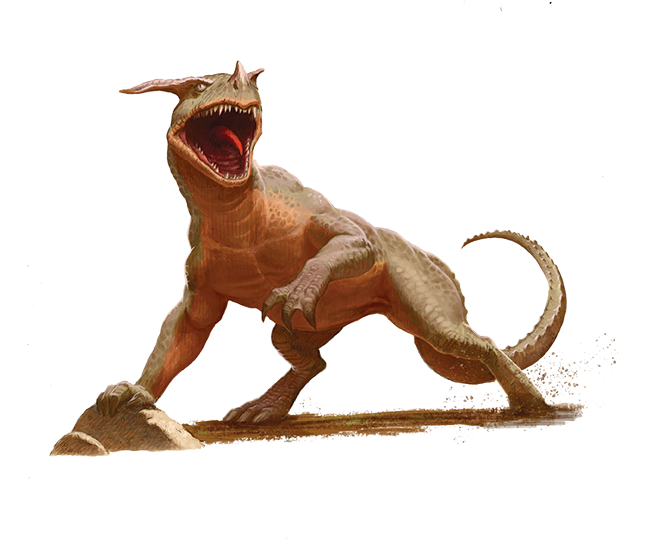Ravenous DrakeSource Alien Archive 4 pg. 98
With the increasing prevalence of Drift travel, the threat of invasive species has grown more dire with each passing decade. Among the most often-cited cases of ecological irresponsibility is the rapid spread of ravenous drakes throughout the Pact Worlds and its trade affiliates beyond.
Ravenous drakes are small, flightless dragons first encountered in the Vast on the forested planet Ajjaika-2. Adults typically measure 2–3 feet in length and weigh about 60 pounds before feeding. Unlike other dragons, these drakes lack a breath attack; instead, their lungs are most biologically efficient when drawing air inward, allowing a drake to create powerful suctioning vortexes that drag prey into the drake’s maw. Combined with their elastic jaws and a digestive system capable of breaking down nearly any matter, whether organic or inorganic, ravenous drakes are consummate scavengers that subsist by devouring anything that they decide might be edible—and lacking the intelligence of true dragons, a ravenous drake considers nearly anything worth eating. This haphazard hunting method results in a short lifespan of about 10 years in natural environments, as they have difficulty differentiating between prey and predators and often find themselves biting off more than they can swallow.
Ravenous drakes rely on a unique reproduction strategy. A receptive female engages in a month-long feeding spree, especially favoring dense minerals. Once sated, she lays an unfertilized egg (or occasionally two) in a safe, sheltered place, relying on the egg’s preternaturally strong shell to protect it until the breeding pair’s male can swallow the egg, brooding it in a specialized egg crop. The weight is so considerable that the male can’t hunt effectively, relying on the female to deliver food during the egg’s 2-month gestation. During this time, the father slowly weakens the egg’s shell, in the process transferring genetic material to the developing young. When the egg cracks, the father regurgitates the offspring and then escorts his child for the first month of life, briefly swallowing the baby when necessary to protect it from larger predators. Eggs that go unfertilized are among the strongest natural materials known to the Pact Worlds and command a sizable price from those with the means to create useful items from the nearly indestructible shell material.
Ravenous drakes came to the Pact Worlds’ attention shortly after the Gap, and the creatures’ willingness to eat anything, their curiosity, and their fearlessness swiftly captured the public imagination. Thanks to their ability to eat almost anything and relatively sedate behavior, the drakes took quickly to domestication, and ravenous drakes (commonly rebranded as gobblewyrms) soon spread across the Pact Worlds as mascots, pets, and vermin control. Domesticated ravenous drakes are calm and often affectionate creatures, though they require extensive training to prevent them from indiscriminately eating inedible objects like personal effects or small furniture.
Yet their voracious appetites makes the drakes an ecological menace. On most settled planets, any unaccompanied and feral ravenous drakes are captured or even killed on sight to preserve local ecosystems. Ownership is highly regulated, with many governments requiring training classes and tracking implants before allowing such creatures beyond a starship’s hold. Understandably, this has fueled a robust black-market trade in the popular pets. The loss or release of a ravenous drake is prosecutable on a few Pact Worlds, with fines going as high as tens of thousands of credits; some drake farms have been bankrupted by the fines when a persistent drake managed to devour its way out of containment and trigger a mass escape.
Scientists studying captive ravenous drakes have noted that the drakes’ growth seems limited only by its diet, positing that a drake with an unlimited supply of suitable food could grow to immense size.Aliens in the "Ravenous Drake" FamilySource Alien Archive 4 pg. 98Feral CR 2 XP 600 XP 600
N Medium dragon
Init +0; Senses darkvision 60 ft., low-light vision;; Perception +7
DefenseHP 25
EAC 13; KAC 15
Fort +6; Ref +6; Will +3
Immunities paralysis, sleep; Resistances acid 5
OffenseSpeed 30 ft., climb 20 ft.
Melee bite +11 (1d6+6 P plus swallow whole) or suctioning vortex +11 (special; see above)
Space 5 ft.; Reach 5 ft. (10 ft. with suctioning vortex)
Offensive Abilities suctioning vortex (attach DC 13; swallow whole [1d6+6 A, EAC 13, KAC 11, 6 HP])StatisticsSTR +4; DEX +0; CON +2; INT -3; WIS +1; CHA +0
Skills Acrobatics +12, Athletics +7, Stealth +7
Languages Common (cannot speak)EcologyEnvironment temperate forests
Organization solitary, pair, or clutch (3–5)Special AbilitiesSuctioning Vortex (Su) As a standard action, a ravenous drake can make a special melee attack targeting KAC by powerfully inhaling, drawing its prey into its mouth. Against a target larger than the drake, this functions as the attach universal creature ability; if the attack succeeds, the drake moves to the nearest adjacent space and attaches to the target. If the attack fails, the drake moves but doesn’t attach.
Against a target of the ravenous drake’s size or smaller, this instead functions in many ways like the swallow whole universal creature ability. The drake gains a +4 bonus to the initial attack roll but doesn’t deal damage upon initially hitting the target. On its subsequent turns, while grappling or pinning the target, the drake deals its bite damage. The drake can swallow a creature of its size or smaller. While it has swallowed a creature of its same size, the drake gains the encumbered and flat-footed conditions.
The movement from this ability—both for the drake and its target—does not provoke attacks of opportunity.
|